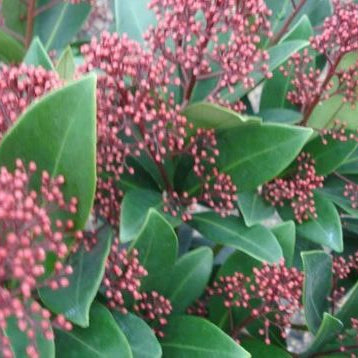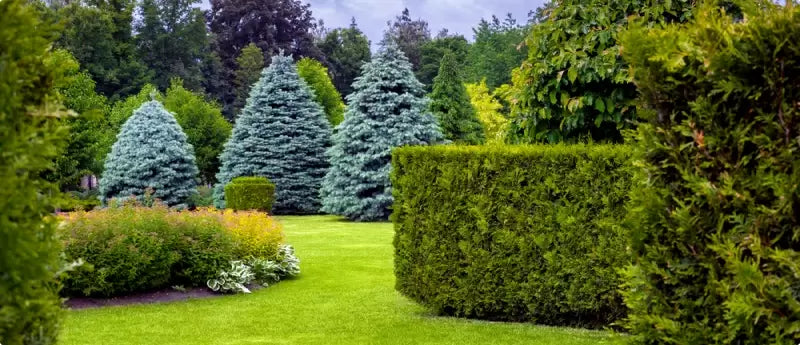
Free Delivery £400+*
Hedging, Tree, Shrubs & more
Free Delivery £400+*

Hedging is popular in gardens across the UK. It’s a great way to gain privacy or add patches of shade to your garden. Plus, it’s a lot nicer to look at than a fence or a wall. It adds texture and intrigue to a garden; and there might even be a berry or two. There are lots of different types of hedges available. There’s evergreen hedging, deciduous hedging, flowering hedging and mixed hedging - and that’s just to start! We’ve created a guide to help you find the right type of hedging for your garden.
 Evergreen versus deciduous
Evergreen versus deciduousEvergreen hedges are there all year, whilst deciduous hedges lose their leaves in winter. Evergreen is the choice for year-round privacy.
 Formal versus informal
Formal versus informalDo you prefer the look of formal or informal hedges? Formal hedges are dense and tightly clipped, whilst informal hedges are less linear and more natural looking.
 Maintenance
MaintenanceAll hedges will need a bit of maintenance, but to different extents. Some evergreen hedges may need trimming a couple of times a year, whilst deciduous hedges might only need it once. On the other hand, deciduous hedges drop their leaves, so will need raking up.
 Height
HeightHow high do you want your hedging to grow? Some hedges may only be a metre tall, whilst others tower ten feet into the air. Consider privacy, as well as how hard it will be to maintain.
 Environment
EnvironmentCertain hedges may need certain conditions to grow. For example, it may need a particular type of soil or amount of sunlight. It’s vital to check this before you buy.
Evergreen hedges are basically what they sound like: hedges that grow all year. The benefit of having an evergreen hedge is that it gives you privacy all year round. However, because they grow all year, they tend to need more maintenance and pruning than other hedges.
There’s still a lot of variety between different types of evergreen hedges! Some might be better for low bordering, whilst others are better for shielding you from nosy neighbours. Plus, different leaves mean different amounts of privacy and shade.
Box hedges are often used for low, formal hedging. Think the hedging alongside a path or to mark out different sections of the garden, for example. Their green, dense leaves make them easy to trim and shape. They are slow growing, so generally only need trimming back once a year. They grow well in any soil.
We sell box hedging at various heights, so you can pick one that’s right for your garden.
Laurel is a classic hedging choice. It has luscious green leaves which grow all year and make a lovely addition to your garden. It is a relatively fast growing hedge, so is a good choice if you want to establish a hedge quickly.
Laurel is fast growing, so may need trimming a couple of times a year. We’d recommend doing this in Spring, ready for new leaves to grow in shape in summer. Plant around 2 feet apart for a dense hedge and avoid waterlogged soil.
Yew hedges are one of the most popular hedging choices in the UK. Notable for their dark green, pine leaves, Yew hedges provide exceptional privacy due to their dense greenery. In fact, Yew is also often sold as a potted plant which can be shaped into cones, balls and spirals.
Yew is another slow growing hedge, so we’d recommend buying them as large as possible. Yew generally only needs trimming once a year to keep it in shape. It will need watering regularly in the first year, but after that it will only need watering in high heat.
We’re used to seeing holly at Christmas, but it’s actually an evergreen plant. Whilst we often think of berries and spiky leaves, not all holly hedges are like this. Only female hedges bear fruit, whilst males do not. Females will also grow white flowers in the Spring. If you buy a female hedge, you should dot in a few males to pollinate it. All holly hedges are dense and can grow very high, so are great for privacy.
Holly is a slow growing hedge, so only needs trimming once or twice a year. We sell our holly hedges in a range of different heights. It is sold in pots and rootball form, so it’s ready for planting straight away. You should plant about 60cm away from each other for a dense hedge with room to grow.
Deciduous hedges drop all their leaves in autumn or winter and grow them back the following spring. This makes them lower maintenance than their evergreen alternatives as there’s less pruning. You might just have a bit of raking up to do in the winter. So if you’re looking for a hands-off, easy to maintain hedge, a deciduous hedge could be for you.
Beech hedging is available in striking green or purple. It makes a great formal hedge and can be anywhere between a metre or 5 metres in height. Its dense leaves offer perfect privacy and shade in your garden. It also makes it popular with wildlife, as many birds choose its bushy leaves to nest in during springtime.
Although deciduous, Beech hedging is very fast growing and can grow up to 60cm every year. That means it may need a trim or cutting back in early summer, if you want to keep its nice, neat shape. Beech hedging can grow in full sun or partial shade, but should not be planted in clay or waterlogged soil.
Hornbeam hedges have brilliant green leaves in spring and summer, before turning a lovely nutty brown in the autumn and winter. Like the Beech hedge, its dense greenery again make it great for privacy.
Hornbeam is a very hardy hedge, which can grow in the most difficult conditions. It can grow up to 40 cm a year in shade, high winds and clay or wet soils. It is usually maintained at between 1-5m.
Hawthorn is another brilliant deciduous hedge option, with the added bonus of lovely white flowers in spring and red berries in autumn. You can expect to see a lot of wildlife around this hedge, as its dense leaves and thorns make it an attractive spot for birds to nest.
A Hawthorn hedge can grow between 20 and 40 cm a year, so will likely need trimming once a year. This should be done in late spring once the flowers have fallen or early autumn.
Of all the different types of hedges, this might be one of our favourites! Flowering hedges are a beautiful addition to your garden, with lovely bright flowers to catch the eye. Generally, flowering hedges are more informal, blending into the garden instead of standing out as a clear demarcation.
Flowering hedges are generally a bit more high maintenance than other hedges - afterall, you can’t just cut it back with a giant hedge trimmer. Instead you’ve got to preen and prune it with your trusty handheld shears. But while they may be more work, we think they’re worth it. Check out some of our favourite types of flowering hedges.
Cottagecore is back. If you’re over 30 (like us) you may be wondering what cottagecore is. Well, think your Grandma’s garden: lots and lots of bright flowers, not particularly well groomed, almost like a meadow. A rose hedge is the perfect choice for a cottagecore garden. It adds privacy and screening, without standing out from the rest of the garden.
A rose hedge is slow growing and will take about 3 years to form a proper hedge. Rose hedges can take a lot of maintenance because it’s more hands-on. You can’t just use a hedge trimmed on a rose hedge - you’ll need the shears for this one. However, the beautiful roses from Summer to Autumn will be well worth it.
Lavender is another lovely choice for a cottagecore or wild garden. It is a low, informal border, which is great for shepherding the journey through your garden. You could plant it to mark out different sections or act as a path through the garden. Enjoy its lovely fragrant smell during summer, which you can also use as aromatherapy to help you sleep.
Lavender is easy to grow and relatively low maintenance. You should plant it in springtime, so that it’s ready to bloom in summer. Simply cut dead blooms to encourage more to grow or just trim once a year in late summer.
Cherry laurel is another evergreen hedge (like its cousin further up in this list) but grows beautiful white flowers in Spring and eventually even berries. Unlike a lot of our other flowering hedges, cherry laurels are large and fast growing, so is still an excellent provider of privacy.
A mixed hedge is a combination of different types of hedges. It’s a range of plants and shrubs, all planted together to create a hedge. Mixed hedges might include a variety of colours, textures and flowers, making them much more interesting to look at than your typical yew hedge.
A mixed hedge is good for the environment too! The mixture of plants is great for attracting a variety of wildlife, so birds, bees and all manner of creatures can enjoy your garden. Using different plants also prevents soil erosion, as they don’t all take the same nutrients from the soil.
Really, you can use any combination of the hedges listed above. You should consider each plant’s different needs, like sunlight, soil type, watering, trimming and so on. For example, if one hedge needs full sun and the other prefers shade, they probably won’t work in a hedge next to each other.
Now you know the different types of hedges available, you can find the one that’s right for you. Here at Grasslands Nursery, we grow all our own hedges and care for them until they are ready to sell. You can purchase hedges online or in person at our garden nursery. Come and see us at WA16 9QY.
Cherry laurels are a very popular hedge as they are evergreen and can grow upto the 3 feet a year. Laurels have large, glossy green leaves, very sm...
View full detailsPrunus Lusitanica - Portuguese Laurel are fantastic laurels that are a great alternative to the classic cherry Laurel. They are more formal in app...
View full detailsBrenelia is a very hardy form of portuguese laurel that also grows a little faster, in a very tidy manner with much redder stems. More graceful in...
View full detailsClassic laurel hedging. It's the country's favourite hedging shrub. Lovely luxurious evergreen dark green leaves. Grows easily in all soils except ...
View full detailsThe posh form of laurel hedging. They cost a little more than common laurel but they are more graceful in appearance with purple shoots and finer l...
View full detailsPrunus lusitanica Angustifolia - Portuguese Laurel are fantastic laurels that are a great alternative to the classic cherry Laurel. They are more f...
View full detailsClassic laurel hedging. It's the country's favourite hedging shrub. Lovely luxurious evergreen bright green leaves. Grows easily in all soils excep...
View full detailsPrunus lusitanica Angustifolia - Portuguese Laurel are fantastic laurels that are a great alternative to the classic cherry Laurel. They are more f...
View full detailsPrunus lusitanica Angustifolia - Portuguese Laurel are fantastic laurels that are a great alternative to the classic cherry Laurel. They are more f...
View full details